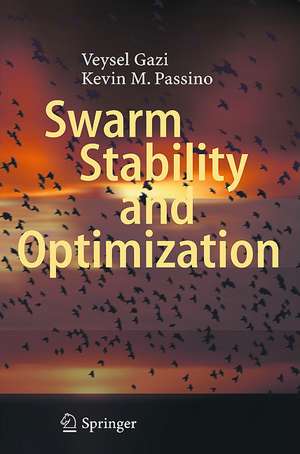Swarm Stability and Optimization
Autor Veysel Gazi, Kevin M. Passinoen Limba Engleză Hardback – 18 ian 2011
fascinating collective behaviors during migration and predator
avoidance. Similarly, engineered multi-agent dynamic systems such as groups of autonomous ground, underwater, or air vehicles (“vehicle swarms”) exhibit sophisticated collective behaviors while maneuvering.
In this book we show how to model and control a wide range of such
multi-agent dynamic systems and analyze their collective behavior
using both stability theoretic and simulation-based approaches. In
particular, we investigate problems such as group aggregation, social
foraging, formation control, swarm tracking, distributed agreement,
and engineering optimization inspired by swarm behavior.
| Toate formatele și edițiile | Preț | Express |
|---|---|---|
| Paperback (1) | 988.16 lei 43-57 zile | |
| Springer Berlin, Heidelberg – 27 noi 2014 | 988.16 lei 43-57 zile | |
| Hardback (1) | 992.44 lei 43-57 zile | |
| Springer Berlin, Heidelberg – 18 ian 2011 | 992.44 lei 43-57 zile |
Preț: 992.44 lei
Preț vechi: 1240.55 lei
-20% Nou
Puncte Express: 1489
Preț estimativ în valută:
189.93€ • 197.55$ • 156.80£
189.93€ • 197.55$ • 156.80£
Carte tipărită la comandă
Livrare economică 14-28 aprilie
Preluare comenzi: 021 569.72.76
Specificații
ISBN-13: 9783642180408
ISBN-10: 364218040X
Pagini: 320
Ilustrații: XVII, 299 p.
Dimensiuni: 155 x 235 x 25 mm
Greutate: 0.57 kg
Ediția:2011
Editura: Springer Berlin, Heidelberg
Colecția Springer
Locul publicării:Berlin, Heidelberg, Germany
ISBN-10: 364218040X
Pagini: 320
Ilustrații: XVII, 299 p.
Dimensiuni: 155 x 235 x 25 mm
Greutate: 0.57 kg
Ediția:2011
Editura: Springer Berlin, Heidelberg
Colecția Springer
Locul publicării:Berlin, Heidelberg, Germany
Public țintă
ResearchCuprins
Part I Basic Principles.- Part II Continuous Time Swarms.- Part III Discrete Time Swarms.- Part IV Swarm Based Optimization Methods.
Recenzii
From the reviews:
“The book is intended as a textbook for a course on multiagent dynamic systems; as a supplementary book in courses on nonlinear control systems, optimization, or discrete-time control systems; or as a reference book for graduate students, researchers, and engineers performing studies or implementation work in the area of multiagent dynamic systems.” (IEEE Control Systems Magazine, Vol. 31, October, 2011)
“The book is intended as a textbook for a course on multiagent dynamic systems; as a supplementary book in courses on nonlinear control systems, optimization, or discrete-time control systems; or as a reference book for graduate students, researchers, and engineers performing studies or implementation work in the area of multiagent dynamic systems.” (IEEE Control Systems Magazine, Vol. 31, October, 2011)
Textul de pe ultima copertă
Swarming species such as flocks of birds or schools of fish exhibit
fascinating collective behaviors during migration and predator
avoidance. Similarly, engineered multi-agent dynamic systems such as groups of autonomous ground, underwater, or air vehicles (“vehicle swarms”) exhibit sophisticated collective behaviors while maneuvering.
In this book we show how to model and control a wide range of such
multi-agent dynamic systems and analyze their collective behavior
using both stability theoretic and simulation-based approaches. In
particular, we investigate problems such as group aggregation, social
foraging, formation control, swarm tracking, distributed agreement,
and engineering optimization inspired by swarm behavior.
fascinating collective behaviors during migration and predator
avoidance. Similarly, engineered multi-agent dynamic systems such as groups of autonomous ground, underwater, or air vehicles (“vehicle swarms”) exhibit sophisticated collective behaviors while maneuvering.
In this book we show how to model and control a wide range of such
multi-agent dynamic systems and analyze their collective behavior
using both stability theoretic and simulation-based approaches. In
particular, we investigate problems such as group aggregation, social
foraging, formation control, swarm tracking, distributed agreement,
and engineering optimization inspired by swarm behavior.
Caracteristici
Complete coverage of swarms
Includes the Basic Principles, Biological Concepts, Theoretical Foundations, Engineering applications of Swarms
Foundations of Swarm Stability and Swarm control
Includes the Basic Principles, Biological Concepts, Theoretical Foundations, Engineering applications of Swarms
Foundations of Swarm Stability and Swarm control
















